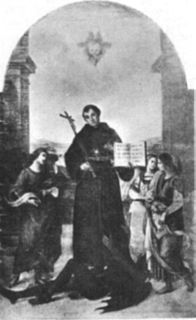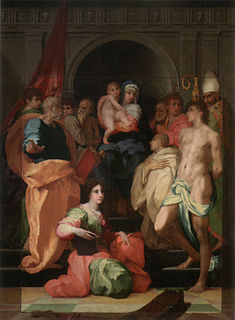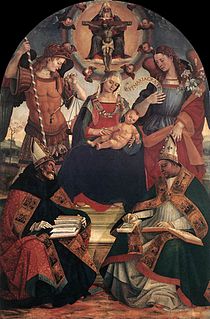 W
WThe Barbadori Altarpiece is a painting by Filippo Lippi, dated to 1438 and housed in the Louvre Museum of Paris.
 W
WThe Baronci Altarpiece was a painting by the Italian High Renaissance artist Raphael. His first recorded commission, it was made for Andrea Baronci's chapel in the church of Sant'Agostino in Città di Castello, near Urbino. The altarpiece was seriously damaged during an earthquake in 1789, and since 1849 fragments of the original painting have been part of different collections.
 W
WThe Boldrone Shrine is located at the corner of the Via di Boldrone and the Via dell'Osservatorio in the Quarto district of Florence. It was named after the monastery of San Giovanni Evangelista di Boldrone, which was itself named after the French "Boldrone" hermitage founded on that site in the 13th century.
 W
WThe Dei Altarpiece is an oil on panel painting by Rosso Fiorentino, commissioned in 1509 by the Dei family and completed in 1522. It is now in Florence's Galleria Palatina, whilst the Uffizi holds a preparatory drawing which may be the original idea for the work.
 W
WThe Disputation on the Trinity is a c.1517 oil on canvas painting by Andrea del Sarto, now in the Galleria Palatina in Florence.
 W
WMadonna and Child with Four Doctors of the Church is a 1540-1545 oil on canvas painting by Moretto da Brescia, now in the Städelsches Kunstinstitut in Frankfurt. From left to right it shows Gregory the Great, Saint Jerome, Saint Ambrose and Augustine of Hippo.
 W
WMadonna and Child with Saints is a c.1545-1546 oil on canvas painting by Tintoretto, now in the musée des Beaux-Arts de Lyon.
 W
WMadonna and Child with the Holy Trinity and Two Saints is a 1510 painting by Luca Signorelli, now in the Uffizi in Florence. It is a sacra conversazione, with the Madonna enthroned between Michael and Gabriel, with Augustine (left) and Athanasius (right) below and the Holy Trinity above.
 W
WThe Nativity Triptych is a 1464–1470 tempera on panel altarpiece by Giovanni Bellini and others. Its central panel of the Nativity measures 127 by 48 cm, its lunette of the Holy Trinity flanked by Augustine and Dominic 59 by 170 cm and its side panels of Francis of Assisi and Victor 103 by 45 cm. It is now in the Gallerie dell'Accademia in Venice.
 W
WMadonna and Child with St John the Baptist and St Augustine is a c.1494 painting by Perugino of the Madonna and Child enthroned between John the Apostle and Augustine of Hippo. It is in the church of Sant'Agostino in Cremona. It was commissioned in 1493 by the rich Roncadelli family and the follow year he painted it at his Florence studio before shipping it to Cremona. It is signed and dated on the throne Petrus Perusinus pinxit MCCCCLXXXXIIII.
 W
WThe Santa Maria dei Fossi Altarpiece is a 1496-1498 painting by Pinturicchio, now in the Galleria nazionale dell'Umbria in Perugia. Unusually for an altarpiece, it is painted on canvas stretched over wooden panels.
 W
WThe Barbadori Altarpiece is a painting by Filippo Lippi, dated to 1438 and housed in the Louvre Museum of Paris.
 W
WThe Saint Augustine Altarpiece is a Catalan Gothic painting in egg tempera by Jaume Huguet and Pau Vergós made between 1462 and 1475. The long duration of the work was caused by financial reasons, and it is assumed that work was begun by Huguet and finished by other members of his workshop, in particular Pau Vergós. The altarpiece was commissioned by the guild of tanners to be placed on the altar of the Augustinian friary of Sant Agustí Vell in Barcelona, Spain. The panel measures 250 x 193 x 9.5 cm and has been in the Museu Nacional d'Art de Catalunya (MNAC) in Barcelona since 1927.
 W
WSaint Augustine and Alypius Receiving Ponticianus is a 1414–1415 painting by Nicolò di Pietro, which has been in the collection of the Musée des Beaux-Arts de Lyon since 2009.
 W
WSaint Augustine in His Study is a painting of Augustine of Hippo executed in 1480 by the Italian Renaissance master Sandro Botticelli. It is in the church of Ognissanti in Florence.
 W
WSaint Augustine in His Study, is a painting by the Italian Renaissance master Sandro Botticelli, finished around 1490–1494. It is housed in the Uffizi, in Florence.
 W
WThe Santo Spirito Altarpiece is a 1521 oil on panel painting by Lorenzo Lotto, signed and dated "L. Lotus / 1521". The work shows the Madonna and Child with saints Catherine of Alexandria, Augustine of Hippo, Sebastian and Anthony the Great. At the foot of the throne is John the Baptist as a child with the Lamb of God.
 W
WSt Augustine is a 1510 oil on silk painting of Augustine of Hippo by Pinturicchio, painted as a gonfalon or processional banner for the Sant'Agostino company of flagellants in Perugia. When that order was suppressed, the work was moved to the Galleria Nazionale dell'Umbria, its present owner.
 W
WSt. Augustine in His Study is a painting by the Italian Renaissance artist Vittore Carpaccio housed in the Scuola di San Giorgio degli Schiavoni of Venice, northern Italy.
 W
WThe Suardi Chapel is an oratory or private chapel inside the villa in Trescore Balneario, Province of Bergamo owned by the Suardi counts. It is dedicated to Saint Barbara and Saint Brigid and was completely rebuilt by the cousins Giovan Battista and Maffeo Suardi. It is fully covered in 1524 frescoes commissioned by them from by Lorenzo Lotto of Christ the Vine and Lives of the Saints. In the 19th century count Gianforte Suardi built a corridor connecting the chapel to the villa and modified the chapel entrance - those entering had previously immediately found themselves in front of the north wall with its depiction of Christ the Vine.
 W
WVirgin in Glory with Saints is a 1510-1515 oil on panel painting by Giovanni Bellini and probably also his studio, now in the Gallerie dell'Accademia in Venice. It measures 3.5 m by 2.25 m and shows the Assumption of Mary, which is usually shown witnessed by the apostles - here it is instead seen by saint Mark, John the Evangelist, saint Luke, Francis of Assisi with the stigmata, Louis of Toulouse as a young bishop, Anthony the Great, Augustine of Hippo and John the Baptist.
 W
WThe Vision of St. John the Evangelist at Patmos (1520-1522) is a series of frescoes by the Italian late Renaissance artist Antonio Allegri da Correggio. It occupies the interior of the dome, and the relative pendentives, of the Benedictine church of San Giovanni Evangelista of Parma, Italy.